Key takeaways:
- Understanding the right fabric for formal wear involves balancing style, comfort, and practicality based on the occasion and season.
- Caring for formal fabrics is crucial; proper washing, ironing, and storage are essential to maintaining their elegance and longevity.
- Choosing sustainable fabrics like organic cotton and recycled polyester can enhance personal style while reflecting environmental values.
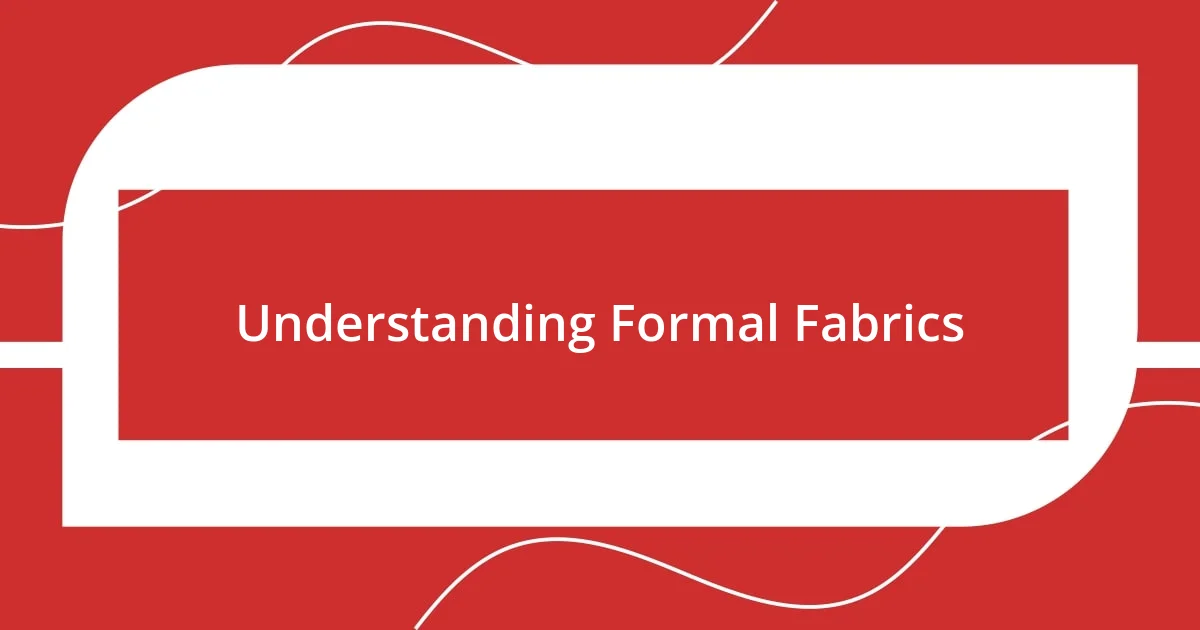
Understanding Formal Fabrics
When thinking about formal fabrics, it’s fascinating to realize how much they can impact our perception of professionalism and elegance. I remember wearing a tailored suit made from pure wool to a job interview; the weight and feel of the fabric instilled a sense of confidence in me that I didn’t expect. Have you ever noticed how slipping into a crisp, well-fitted outfit can shift your mindset entirely?
Different fabrics each tell their own story in formal settings. For instance, silk has a luxurious sheen that can elevate an outfit, but it can also be daunting to maintain. I once splurged on a silk tie that I was terrified to wear because of the care it needed—talk about a balancing act between style and practicality!
Understanding the composition of these materials is key. Fabrics like linen and cotton bring breathability, which I learned the hard way during an outdoor wedding—it was hot, and my suit felt suffocating! So, as you explore formal fabrics, consider both aesthetics and comfort; it’s all about finding that perfect blend that works for your unique style and the occasion.
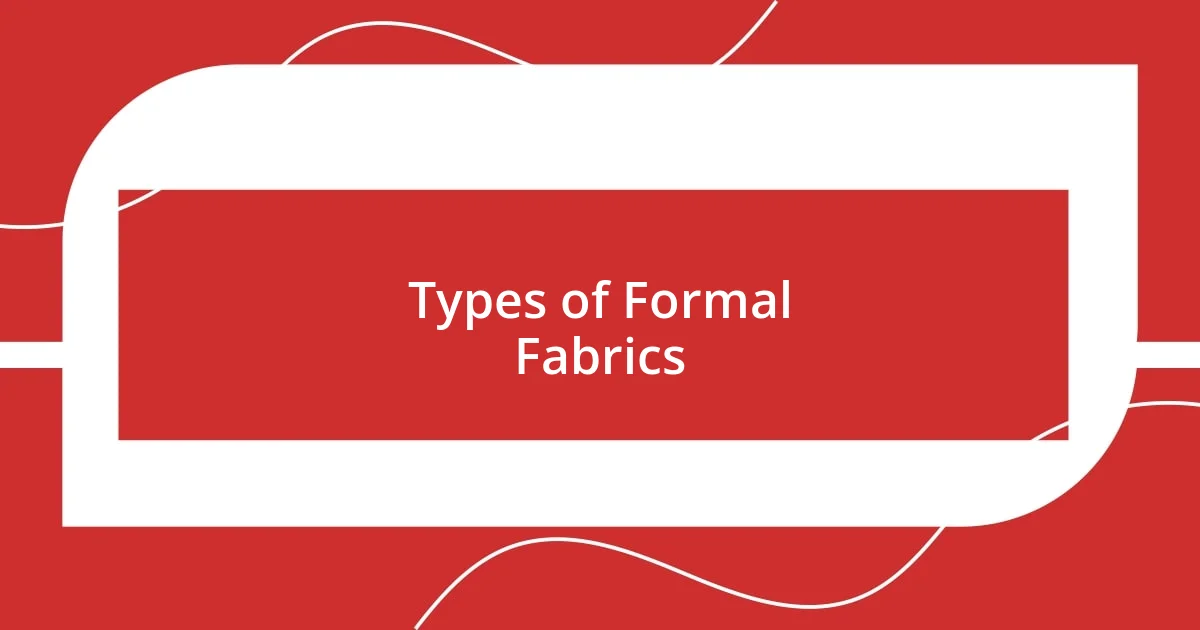
Types of Formal Fabrics
The world of formal fabrics is quite diverse, each type offering unique qualities that influence both style and comfort. For example, wool is a favorite among many professionals, including myself. I fondly recall attending a formal winter gala in a wool tuxedo; its warmth and textured feel made me feel both sophisticated and cozy. On the other hand, fabrics like polyester provide a different aesthetic; they’re great for wrinkle resistance but can sometimes feel less breathable. Have you ever encountered that moment when you realized a fabric wasn’t living up to its reputation?
Then there’s cotton, which I used in a blazer for a summer wedding. It was lightweight and comfortable, allowing me to dance the night away without overheating. However, the downside is that cotton often lacks the luxurious finish of other materials. This experience taught me to weigh factors like warmth, feel, and overall appearance when choosing fabrics for different occasions.
Let’s not forget about synthetic blends, which can be quite impressive. I’ve worn a sleek dress shirt made from a cotton-polyester blend, and I was surprised by how well it held up throughout the day. It’s remarkable how some blends can feel both luxurious and practical, making formal wear versatile for various situations.
| Fabric Type | Characteristics |
|---|---|
| Wool | Warm, textured, often luxurious; great for colder months. |
| Cotton | Lightweight, breathable, but may lack luster. |
| Polyester | Wrinkle-resistant, durable; can feel less breathable. |
| Synthetic Blends | Versatile, combines luxury with practicality. |
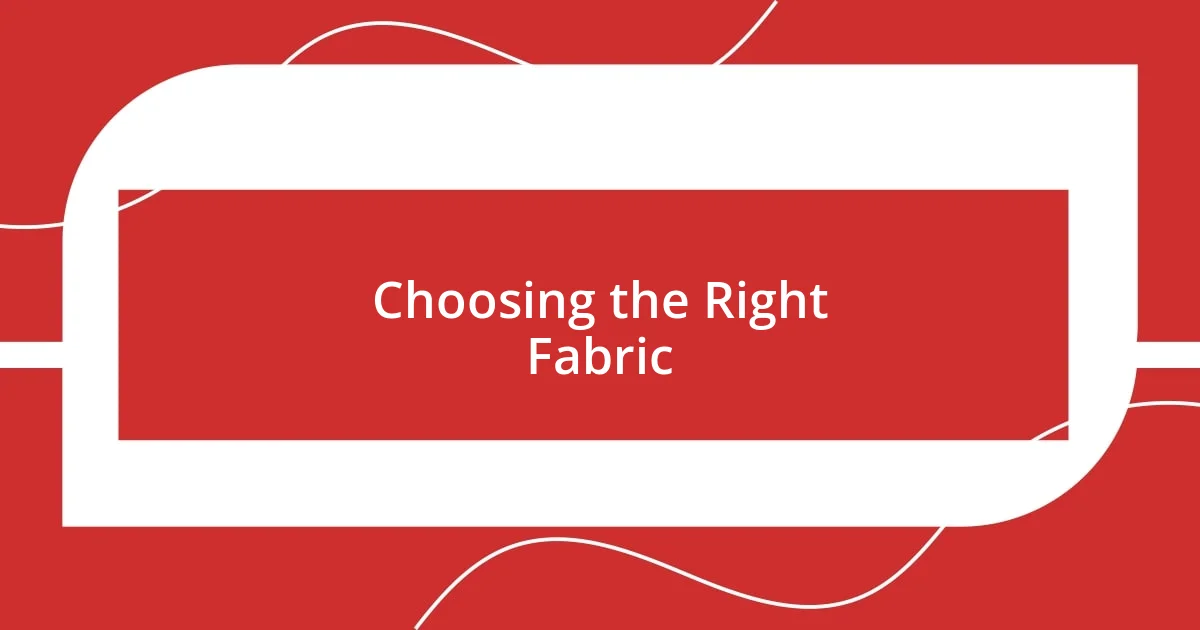
Choosing the Right Fabric
Choosing the right fabric for formal occasions can feel overwhelming, but I’ve learned to prioritize comfort alongside style. For a charity gala a few years ago, I chose a blend of wool and cashmere for my suit. The moment I slipped it on, the softness enveloped me, and I couldn’t help but smile. It effortlessly combined elegance with ease, allowing me to mingle and navigate the evening without a care in the world, feeling confident and put together.
When considering fabrics, here are some key factors to keep in mind:
– Occasion: What is the event? Formality dictates fabric choice.
– Season: Lighter materials work well in summer while thicker fabrics are better for winter.
– Care: Some fabrics like silk demand more maintenance; if you travel often, you might want to reconsider.
– Fit and Feel: Ensure the fabric feels good against your skin and allows freedom of movement.
– Layering: Think about how the fabric layers; the right choice can add sophistication without bulk.
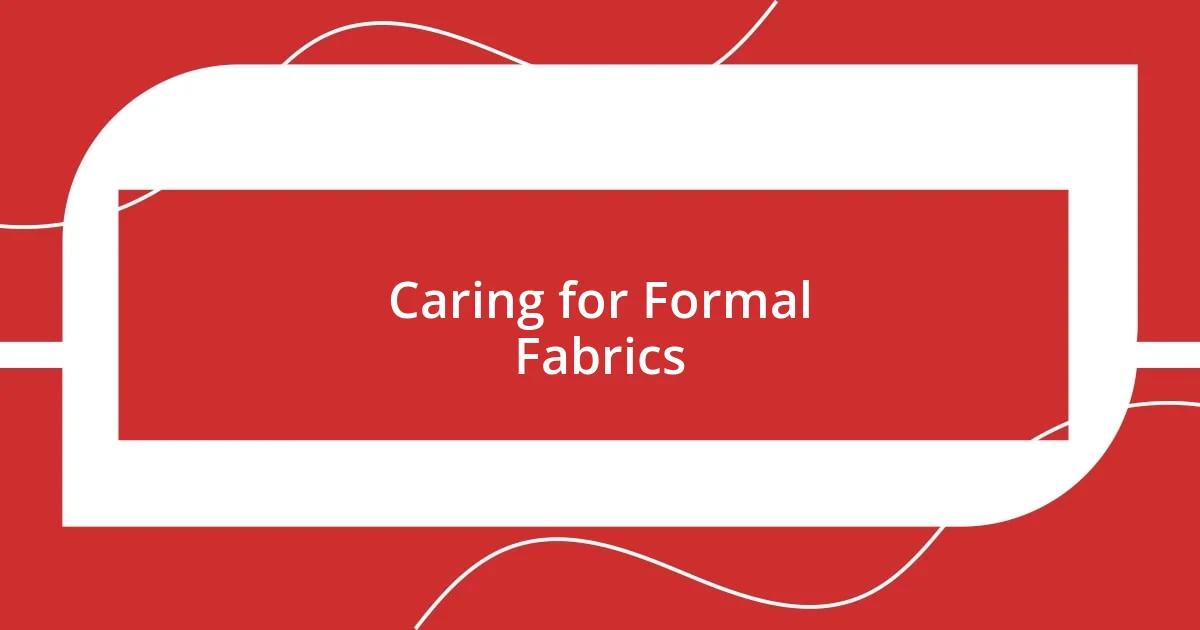
Caring for Formal Fabrics
Caring for formal fabrics is essential to maintain their elegance and longevity. I remember my first formal dress shirt; after a couple of washes, I noticed it started losing its crisp look. It was then I realized that temperature matters! Always check the care instructions, and when in doubt, opt for cold water to prevent shrinking or fading.
Ironing can also feel daunting, especially with delicate fabrics like silk. I once tried to steam a silk tie and ended up with an unintended shine mark! Now, I always use a low heat setting and a pressing cloth; this simple trick has saved many pieces from disaster. Trust me, investing a little time in proper ironing techniques offers a world of difference in keeping your attire looking sharp.
Lastly, I can’t stress enough the importance of storage. When I haphazardly tossed my evening gown into the back of my closet, I returned to find it wrinkled beyond repair. Now, I use padded hangers and garment bags for my most delicate fabrics. How do you store your formal wear? With the right storage, you’ll preserve the beauty and structure of your garments, making every event a chance to dazzle.
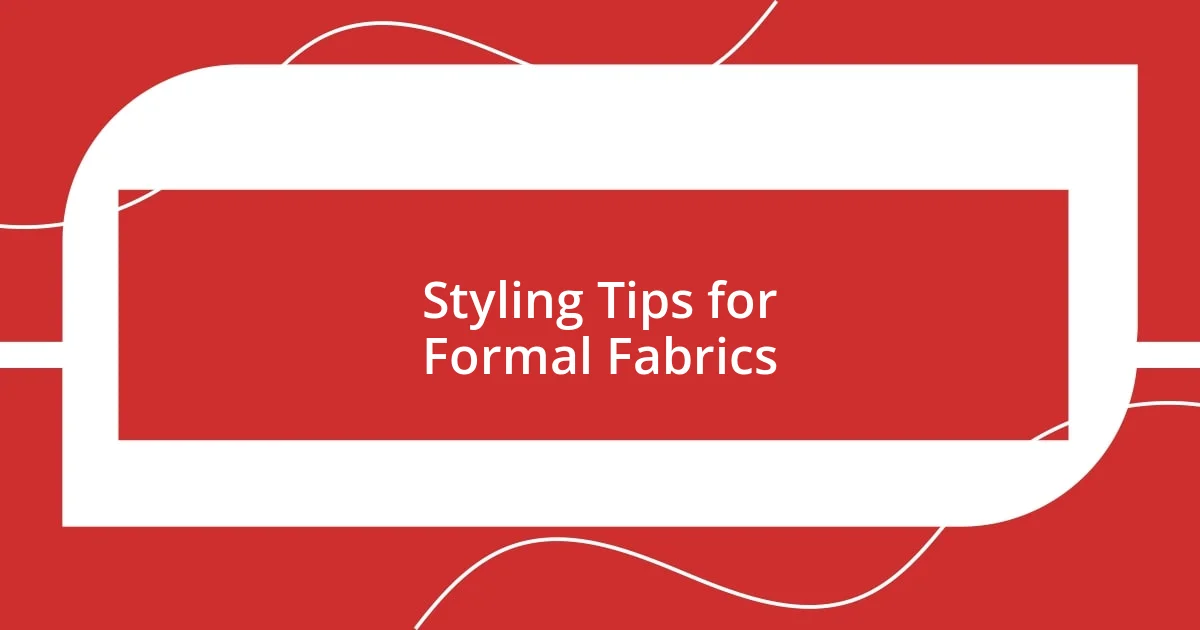
Styling Tips for Formal Fabrics
When it comes to styling with formal fabrics, choosing the right color and pattern can elevate your look significantly. I remember attending a wedding where I opted for a deep emerald green blazer paired with tailored black trousers. The combination not only highlighted the fabric’s rich texture but also added a unique touch that made me feel both chic and classy. What color or pattern resonates with you? Sometimes, stepping outside the usual color palette can make a lasting impression.
Accessorizing is another key element that shouldn’t be overlooked. A sleek and modern belt or a subtle pocket square can bring your outfit together beautifully. I once paired a structured blazer with a patterned pocket square, and the simple addition transformed my entire look from ordinary to extraordinary. Have you ever considered how small details can have such a big impact? Always choose accessories that complement rather than overshadow your formal fabric choices.
Lastly, fit is everything when it comes to formal wear. Investing time in tailoring can make a world of difference. I learned this the hard way when I wore a suit that was slightly too big; it not only looked unkempt but also made me feel self-conscious throughout the event. A well-fitted suit conveys confidence. So, how well does your formal wear fit? A few adjustments can make you feel like a million bucks while showcasing the elegance of your formal fabrics.
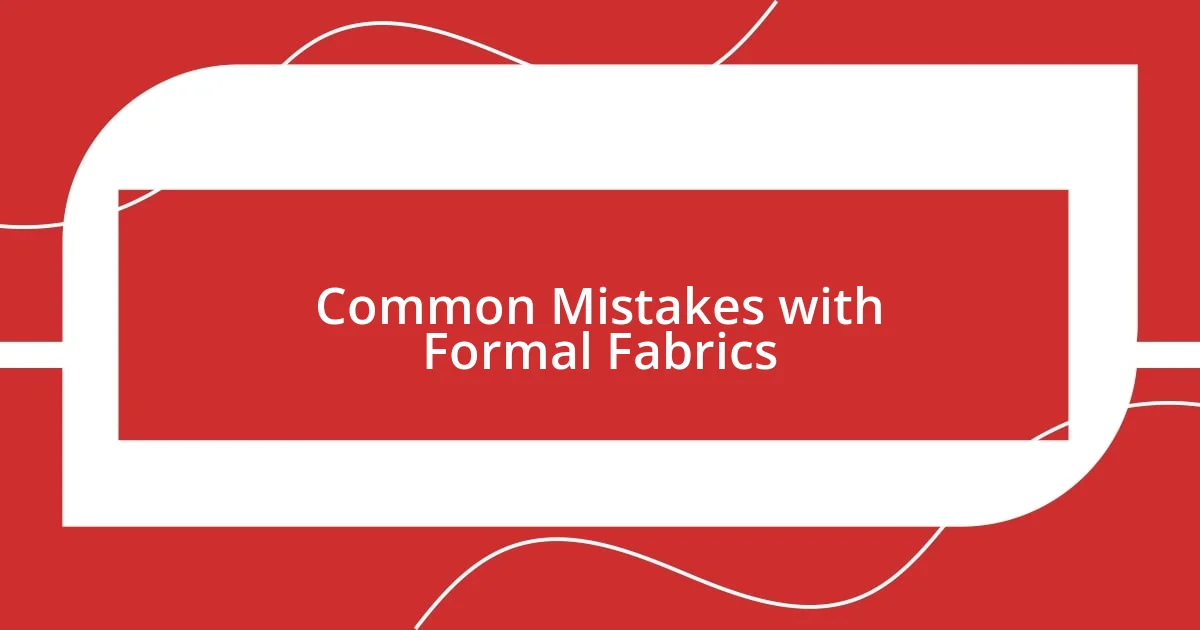
Common Mistakes with Formal Fabrics
One of the most common mistakes I see people make with formal fabrics is ignoring the importance of fabric blends. I once bought a suit that was made of a cheap poly-blend, thinking it would be low maintenance. Sadly, it wrinkled easily and didn’t breathe well at all, making it uncomfortable during a long evening event. Have you ever experienced that awful sweaty feeling at a formal gathering? Trust me, choosing a higher quality fabric blend, like wool or a silk-cotton mix, can significantly enhance comfort and appearance.
Another pitfall is neglecting the scale of patterns and textures. I remember pairing a bold plaid shirt with a patterned tie for a presentation, thinking I was fashion-forward. Instead, I looked like I had gotten dressed in the dark! In formal settings, striking the right balance is crucial. Have you thought about how overwhelming patterns can confuse your overall look? Simpler styles often work better, allowing the elegance of the fabric to shine through.
Finally, many people forget to consider the occasion when selecting formal fabrics. I once wore a heavy velvet blazer to an outdoor summer wedding, and it was a regrettable choice! The heat was unbearable, and I felt out of place. Do you take the environment into account when dressing? Always adapt your fabric choice to suit the occasion and climate for optimal comfort and style.
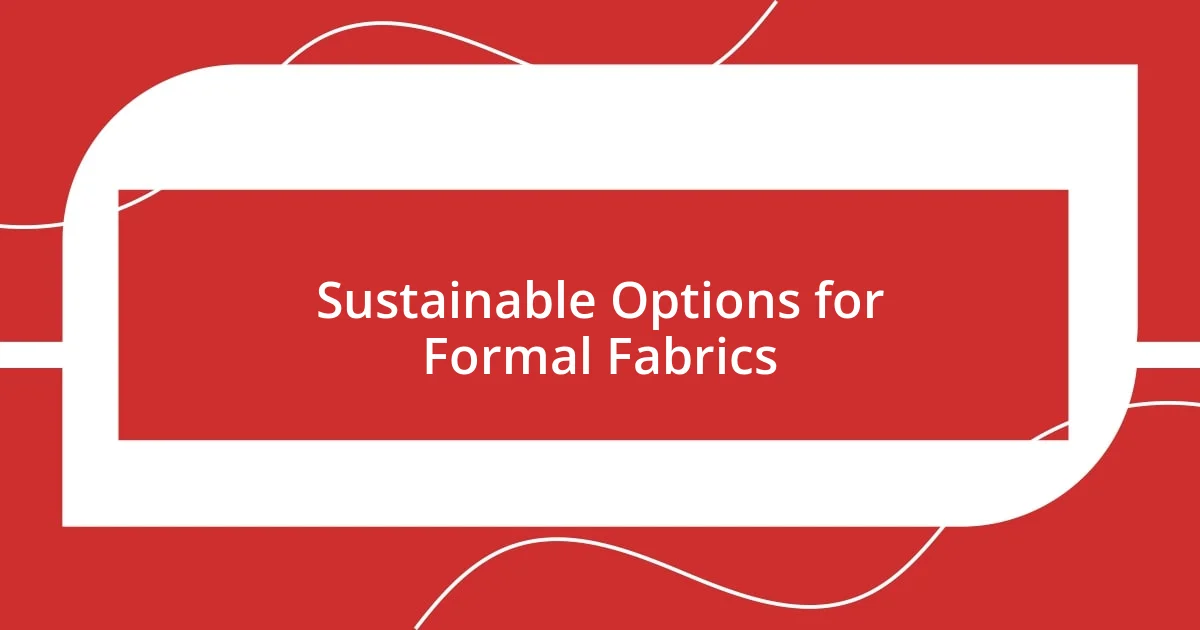
Sustainable Options for Formal Fabrics
When exploring sustainable options for formal fabrics, I found that organic cotton is a fascinating choice. I still remember trying on an organic cotton blazer that felt soft and breathable, yet still looked polished. It made me realize how a fabric can be kind to the planet while keeping me stylish. Have you ever considered how the fabric you wear can reflect your values?
Recycled polyester is another innovative option that caught my attention. I was once amazed to learn that this material can be made from discarded plastic bottles. It’s incredible to think that one person’s waste can be transformed into a chic formal garment. Have you ever thought about the journey of your clothing before it reached your wardrobe? Choosing items made from recycled materials can feel empowering, knowing you’re contributing to a reduction in landfill waste.
Linen, while often overlooked, is a superb natural choice for elegant dressing. My first linen suit was an eye-opener; it was light, perfect for summer events, and showcased a relaxed yet refined vibe. I felt effortlessly classy, especially when I paired it with a linen shirt. What fabric choices make you feel good not just about your appearance but also about your impact on the environment? Embracing sustainable fabrics can enhance both your style and conscience.















